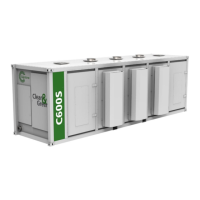Capstone Turbine Corporation • 16640 Stagg Street • Van Nuys • CA 91406 • USA
Installation Guide: Capstone C1000S/C800S/C600S with C1000 Series Controller
480064 Rev C (December 2018) Page 60 of 122
Capstone reserves the right to change or modify, without notice, the design, specifications, and/or contents of this document without
incurring any obligation either with respect to equipment previously sold or in the process of construction.
6.2. Raw Natural Gas
Raw natural gas — also called wellhead gas or associated gas — is a product of oil and gas
drilling and can be found at oil wells, gas wells, and condensate wells. The gas is unprocessed
and can contain varying concentrations of heavier hydrocarbons, contaminants such as hydrogen
sulfide (H
2
S) and chlorides, and diluents such as carbon dioxide (CO
2
) and nitrogen.
Special pretreatment consideration must be taken with raw natural gas due to possible high
concentration of hydrogen sulfide (H
2
S), water vapor, carbon dioxide (CO
2
), heavy hydrocarbons,
and other contaminants.
Refer to the Raw Natural Gas Application Guide (Table 1) for information on allowable fuels,
properties, requirements, and delivery.
6.3. Biogas
Biogas, either digester gas or landfill gas, originates from the anaerobic digestion of organic waste
materials. The primary byproducts of this process are methane (CH
4
) and carbon dioxide (CO
2
),
with the solid residues rendered essentially inert.
Special pretreatment consideration must be taken with biogas gas due to possible high
concentration of hydrogen sulfide (H
2
S), water vapor, carbon dioxide (CO
2
), siloxanes, and other
contaminants.
Refer to the Biogas Application Guide (Table 1) for information on allowable fuels, properties,
requirements, and delivery.
6.4. Liquefied Petroleum Gas (LPG)
Liquefied Petroleum Gas (LPG) is characterized as a mixture of propane, butane, and small
quantities of various other hydrocarbons such as propylene and butylene. LPG is transferred and
stored as a pressurized liquid. Its boiling point is such that it evaporates easily under ambient
temperature and pressure. The composition of LPG determines the dew point, heating value,
density, and other fuel properties, as well as the percentage of contaminants.
Special pretreatment consideration must be taken with LPG due to the need to vaporize the liquid
fuel into a gaseous state. LPG also has a low dew point relative to other fuels.
Contact your local Capstone Turbine authorized distributor for information on allowable fuels,
properties, requirements, and delivery.
Refer to the LPG Application Guide (Table 1) for information on allowable fuels, properties,
requirements, and delivery.
6.5. General Considerations for Gaseous Fuels
6.5.1. Pressure
Fuel pressure requirements apply at the microturbine fuel inlet while the system is running.
Pressure should be steady when entering the microturbine. Avoid pressure fluctuation by correctly
sizing the piping, regulator, valves, and ancillary equipment of the fuel delivery system.

